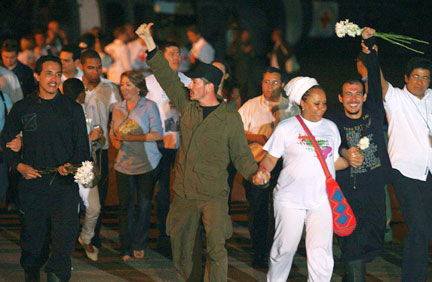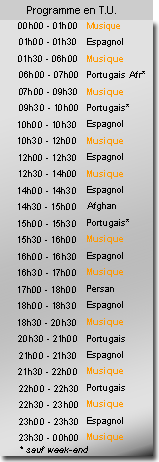Colombia
Farc hands over four hostages
Article published on the 2009-02-02 Latest update 2009-02-02 14:35 TU

Soldier Giovanni Dominguez (L), police officers Alexis Torres (C) and Walter Lozano (R) greet the crowd upon their arrival in Villavicencio, 1 February 2009
(Photo: Reuters)
“It was 20 difficult months,” said police officer Juan Fernando, one of the hostages, who was dropped off in Villavicencio by a helicopter provided by Brazil for the rescue operation.
Two other police officers and a soldier were released. They are part of a group of six that Farc had promised to release by Wednesday. An operation is set today to rescue Alan Jara, a former governor who was kidnapped in 2001. Former lawmaker Sigifredo Lopez is expected to be released Wednesday.
In December Farc had promised to release the hostages, in what it described as a goodwill gesture. British Latin American analyst Colin Harding told RFI that it looks as though Farc is trying to win the favour of the government in order to negotiate the release of their own prisoners - some 500 guerrillas in jail in Colombia and the US.
“There are a lot of guerrillas held, imprisoned by the government,” he said. “And all along they’ve been trying to get the government to engage a swap of prisoners.”
Analysis: Colin Harding, Latin American specialist from London
After the two politicians are released later this week, Farc will hold 22 other “political” hostages. Harding says the remaining hostages are senior officers.
“By holding on to more senior military and police officers, they’re hoping for a swap with their own officers, if you like, which would force the government to recognized there is a real armed conflict going on in Colombia, which is one of their aims: they are not just terrorists, this is actually a war,” he said. “They’re going to release a couple of politicians later this week, and effectively all they’ll have left then will be quite senior military people.”
While the rescue operation was underway, a car bomb exploded near a police station in Cali, to the southwest, killing one person and injuring four. The city’s police chief blamed Farc.
Harding says that if Farc is indeed behind the blast, it’s an indication that the guerrilla’s communications are breaking down.
“It’s not absolutely clear to what extent the Farc are working as a unit all over the country,” said Harding.
“All the indications are that the Farc senior command are trying to hang on, but finding it increasingly difficult to do so,” he added.







